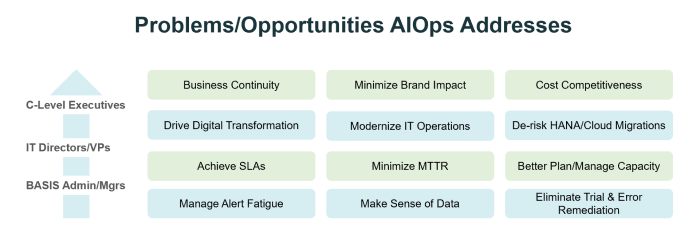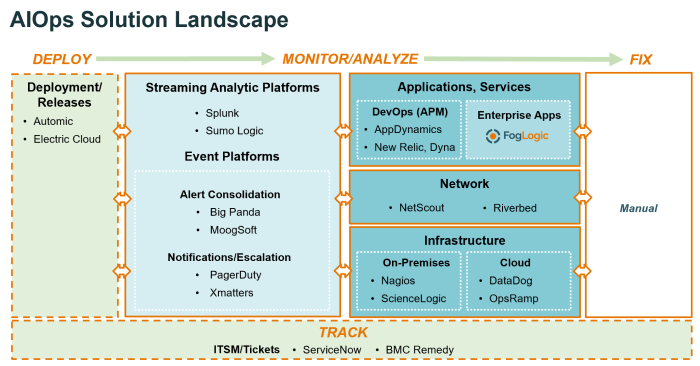
The market for AIOps tools is exploding. According to Forrester Research, only 12% of organizations rely exclusively on modern tools to support IT operations. Yet 68% of companies are planning to invest in AIOps-enabled monitoring solutions over the next year. So, if you plan to keep pace with your industry peers by using modern tools, but haven’t begun educating yourself on the power of AIOps and relevant solution options, you’re already behind.
It’s OK to Be Confused
This post will focus on helping you make sense of the bewildering landscape of AIOps solution options. Let’s start with understanding what’s driving the confusion among those new to AIOps as well as those who have done their research. Typically, in mature product market segments, vendor marketing messages, value propositions, and benefits tend to converge. Over time, everybody starts to sound the same. But this is already happening in the emerging AIOps solution space. Almost every vendor will claim full-stack visibility, decreased alert fatigue, reduced mean time to recovery (MTTR), contextualized data, and a future driven by machine learning, autonomous operations, digital transformation, and [insert your favorite technology buzz word here].
Why is this happening? I have some theories.
First, the market growth opportunity I alluded to already has attracted so many entrants that they struggle to differentiate themselves. Second, in attempting to appeal to executive decision-makers, these AIOps providers tend to oversimplify and genericize their messages. Finally, AIOps vendors share a common vision of autonomous, self-healing systems and the ability to address all application types, stack layers, and deployment scenarios. This may lead to converging vendor claims and messages when marketers fail to distinguish between product aspirations and their focus or current capabilities.
The AIOps Solution Reality
The inconvenient truth is that there isn’t a single vendor solution today that can tackle the spectrum of IT operations challenges across all domains. For example, supporting an SAP landscape is very different from a DevOps/e-commerce environment.
As a result, the world of AIOps is very broad and multidimensional. This means there are a lot of tools that all sound the same but have distinct strengths and weaknesses relative to particular domains—once you pierce the marketing veneer. But you can make sense of the market and narrow the field of relevant solutions by first identifying the domain-specific problems you are trying to solve, and then developing a solution landscape populated only by vendors that address the problems in that domain.
What Problem Are You Trying to Solve?
Before you start to think about solutions, you should first perform an IT operations self-assessment to determine if your company is ready for AIOps. Most companies make the mistake of not properly identifying the problem they are trying to solve, determining if the problem is worth solving, and understanding if the organization is positioned to solve it. If you do a good job with the first part of your readiness assessment (problem identification), you will have an easier time narrowing the field of relevant solution providers.
To summarize, there are two simple keys to understanding your relevant solution options. First, accept that there is no such thing as a single-vendor solution (otherwise known as a “Single Pane of Glass”). Second, narrow the field of potential solution providers by identifying both the problem(s) and the related domains that you are trying to address. Here are some problems and opportunities AIOps may address for different levels of your organization:

Build Your AIOps Solution Landscape
Once you have completed your self-assessment and have successfully made a business case to pursue an AIOps initiative, you will be ready to begin evaluating various solution options. A good way to do that is to build or adopt an AIOps solution landscape. This will put the problem you are trying to solve into perspective by illuminating what problems you are not solving, as well as identifying potential integration points or adjacent solutions that can represent next steps in a multi-year IT ops modernization journey.
The Challenge of Building an AIOps Solution Landscape
There are so many ways to slice and dice the AIOps market that you will find it difficult to build a simple and logical model to neatly map various solution providers (e.g., two-dimensional matrix or process flow). You may have to consider solution dimensions such as:
- Application layer versus infrastructure focus
- Ready-made solutions versus development platforms
- SaaS solutions versus on-premise or hybrid tools
- Native artificial intelligence (AI) technology versus legacy tool extensions
- Domain-aware contextualization versus pure, data-driven AI
The landscape depicted below can be used as a starting point for building your own personalized solution map geared to your own challenges and pain points. It blends a basic IT operations process view (deploy, monitor/analyze, fix) with some other key delimiters like a solution stack layer.

This landscape is not perfect, and some vendor solutions may transcend some of the boundaries. But to keep the map simple, a good rule is to map vendors to the solution landscape component that aligns best with their core strength (which is often largely a function of their product heritage). This helps you make sure you are dealing with best-in-breed tools. Note also that your solution stack may include a business process layer above app/services. Because this is an emerging area with fewer proven solutions, and for the sake of simplicity, it is not represented here.
Recommendations to Evaluate AIOps Vendors
If your operations domain is SAP and you care only about system and behavior incidents that affect users, you should be focused on the Enterprise Apps category within the Applications, Services level of the stack. When it’s time to evaluate specific vendors, here are some best practices:
- Find a solution with SAP domain awareness and the ability to contextualize data, deliver insights, and make recommendations that are meaningful in an SAP environment.
- Make sure your solution provides a holistic view across SAP, database, and infrastructure layers to deliver faster data correlations and conclusions.
- Prioritize enterprise-ready (secure and scalable) SaaS solutions that are easy to use and deliver actionable packaged insights.
- If you work with an outsourced third party to manage your everyday operations, investigate the potential of deploying AIOps to regain a level of IT control and visibility, perform effective IT oversight, and enhance collaboration.
Join us for the ASUG and SAP Solution Manager Summit Nov. 5–7 in Newtown Square, Pennsylvania. Additionally, we welcome all ASUG members to submit their ideas for blog posts they want to write.